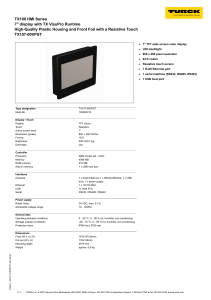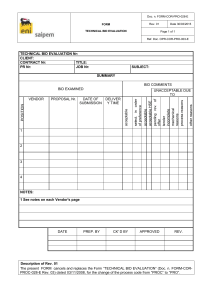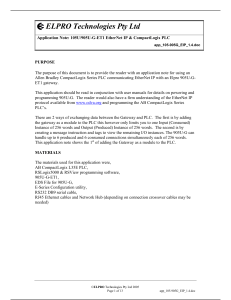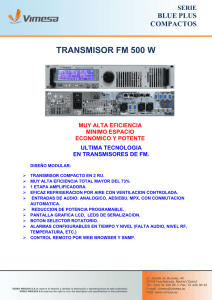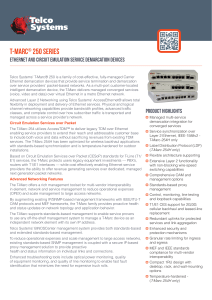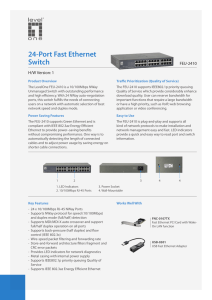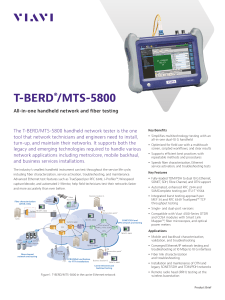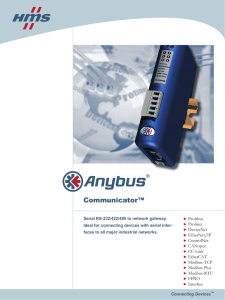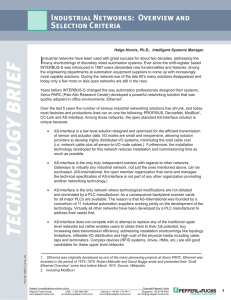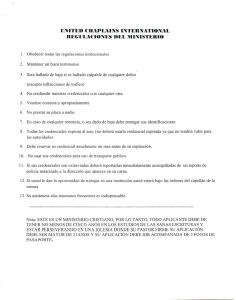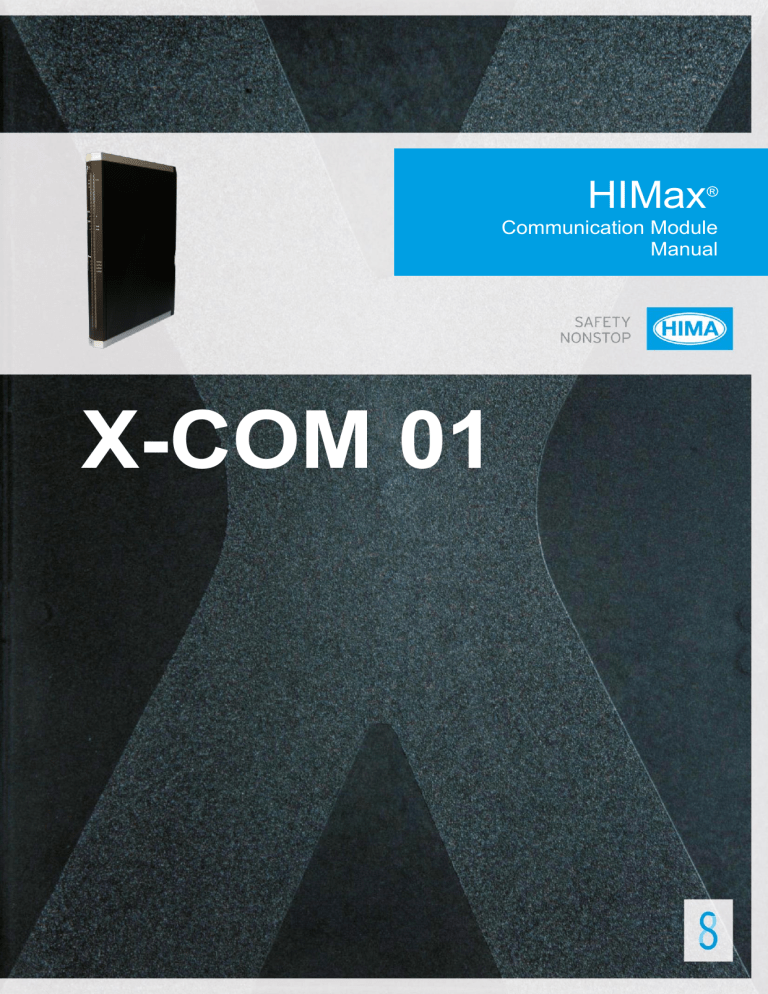
HIMax ® Communication Module Manual X-COM 01 All HIMA products mentioned in this manual are protected by the HIMA trade-mark. Unless noted otherwise, this also applies to other manufacturers and their respective products referred to herein. All of the instructions and technical specifications in this manual have been written with great care and effective quality assurance measures have been implemented to ensure their validity. For questions, please contact HIMA directly. HIMA appreciates any suggestion on which information should be included in the manual. Equipment subject to change without notice. HIMA also reserves the right to modify the written material without prior notice. For further information, refer to the HIMA DVD and our website at http://www.hima.de and http://www.hima.com. © Copyright 2013, HIMA Paul Hildebrandt GmbH + Co KG All rights reserved Contact HIMA contact details: HIMA Paul Hildebrandt GmbH + Co KG P.O. Box 1261 68777 Brühl, Germany Phone: +49 6202 709-0 Fax: +49 6202 709-107 E-mail: [email protected] Revision index Revisions Type of change technical editorial 4.00 New edition for SILworX V4 X X 5.00 New edition for SILworX V5 Revised: Chapter 3.5 X X HI 801 011 E Rev. 5.00 (1334) X-COM 01 Table of Contents Table of Contents 1 Introduction 5 1.1 Structure and Use of the Manual 5 1.2 1.3 1.3.1 1.3.2 Target Audience Formatting Conventions Safety Notes Operating Tips 5 6 6 7 2 Safety 8 2.1 2.1.1 2.1.2 Intended Use Environmental Requirements ESD Protective Measures 8 8 8 2.2 2.3 Residual Risk Safety Precautions 9 9 2.4 Emergency Information 9 3 Product Description 3.1 3.1.1 3.2 Safety Function Reaction in the Event of a Fault HIMax COM Module Part Number 10 10 10 3.3 Type Label 12 3.4 3.4.1 3.4.2 3.4.3 3.4.4 3.4.5 3.4.6 3.4.7 3.4.8 3.5 Structure Block Diagram Processor System Indicators Module Status Indicators Redundancy indicators System Bus Indicators Fieldbus Indicators Ethernet Indicators Product Data 13 13 14 15 16 17 17 18 18 19 3.6 3.6.1 3.6.2 Connector board Pin Assignment Fieldbus interfaces 20 20 21 4 Start-up 4.1 4.2 4.2.1 4.2.2 4.3 4.3.1 4.3.2 Mounting Mounting and Removing the Module Mounting a Connector Board Mounting and Removing the Module Configuring the Module in SILworX The Tabs of the Detail View Network Ports Used for Ethernet Communication 5 Operation 5.1 5.2 Handling Diagnosis HI 801 011 E Rev. 5.00 10 22 22 22 22 24 26 26 31 32 32 32 Page 3 of 42 Table of Contents X-COM 01 6 Maintenance 6.1 6.1.1 6.1.2 Maintenance Measures Loading the Operating System Proof Test 7 Decommissioning 34 8 Transport 35 9 Disposal 36 Appendix 37 Page 4 of 42 33 33 33 33 Glossary Index of Figures 37 38 Index of Tables Index 39 40 HI 801 011 E Rev. 5.00 X-COM 01 1 1 Introduction Introduction The present manual describes the technical characteristics of the module and its use. It provides information on how to install, start up and configure the module in SILworX. 1.1 Structure and Use of the Manual The content of this manual is part of the hardware description of the HIMax programmable electronic system. This manual is organized in the following main chapters: Introduction Safety Product Description Start-up Operation Maintenance Decommissioning Transport Disposal Additionally, the following documents must be taken into account: Name HIMax System Manual HIMax Safety Manual HIMax Communication Manual SILworX Online Help (OLH) First Steps Table 1: Content Hardware description of the HIMax system Document no. HI 801 001 E Safety functions of the HIMax systems HI 801 003 E Description of communication and protocols HI 801 101 E Instructions on how to use SILworX Introduction to SILworX HI 801 103 E Additional Valid Manuals The latest manuals can be downloaded from the HIMA website at www.hima.com. The revision index on the footer can be used to compare the current version of existing manuals with the Internet edition. 1.2 Target Audience This document addresses system planners, configuration engineers, programmers of automation devices and personnel authorized to implement, operate and maintain the devices and systems. Specialized knowledge of safety-related automation systems is required. HI 801 011 E Rev. 5.00 Page 5 of 42 1 Introduction 1.3 X-COM 01 Formatting Conventions To ensure improved readability and comprehensibility, the following fonts are used in this document: Bold Italics Courier RUN Chapter 1.2.3 To highlight important parts Names of buttons, menu functions and tabs that can be clicked and used in the programming tool. For parameters and system variables Literal user inputs Operating state are designated by capitals Cross references are hyperlinks even though they are not particularly marked. When the cursor hovers over a hyperlink, it changes its shape. Click the hyperlink to jump to the corresponding position. Safety notes and operating tips are particularly marked. 1.3.1 Safety Notes The safety notes are represented as described below. These notes must absolutely be observed to reduce the risk to a minimum. The content is structured as follows: Signal word: warning, caution, notice Type and source of risk Consequences arising from non-observance Risk prevention SIGNAL WORD Type and source of risk! Consequences arising from non-observance Risk prevention The signal words have the following meanings: Warning indicates hazardous situation which, if not avoided, could result in death or serious injury. Warning indicates hazardous situation which, if not avoided, could result in minor or modest injury. Notice indicates a hazardous situation which, if not avoided, could result in property damage. NOTE Type and source of damage! Damage prevention Page 6 of 42 HI 801 011 E Rev. 5.00 X-COM 01 1.3.2 1 Introduction Operating Tips Additional information is structured as presented in the following example: i The text corresponding to the additional information is located here. Useful tips and tricks appear as follows: TIP The tip text is located here. HI 801 011 E Rev. 5.00 Page 7 of 42 2 Safety 2 X-COM 01 Safety All safety information, notes and instructions specified in this manual must be strictly observed. The product may only be used if all guidelines and safety instructions are adhered to. This product is operated in accordance with SELV or PELV. No imminent danger results from the module itself. The use in Ex-Zone is permitted if additional measures are taken. 2.1 Intended Use HIMax components are designed for assembling safety-related controller systems. When using the components in the HIMax system, comply with the following general requirements 2.1.1 Environmental Requirements Requirement type Protection class Ambient temperature Storage temperature Pollution Altitude Housing Supply voltage Table 2: Range of values Protection class III in accordance with IEC/EN 61131-2 0...+60 °C -40...+85 °C Pollution degree II in accordance with IEC/EN 61131-2 < 2000 m Standard: IP20 24 VDC Environmental Requirements Exposing the HIMax system to environmental conditions other than those specified in this manual can cause the HIMax system to malfunction. 2.1.2 ESD Protective Measures Only personnel with knowledge of ESD protective measures may modify or extend the system or replace modules. NOTE Device damage due to electrostatic discharge! When performing the work, make sure that the working area is free of static and wear an ESD wrist strap. If not used, ensure that the device is protected from electrostatic discharge, e.g., by storing it in its packaging. Page 8 of 42 HI 801 011 E Rev. 5.00 X-COM 01 2.2 2 Safety Residual Risk No imminent risk results from a HIMax system itself. Residual risk may result from: Faults related to engineering Faults related to the user program Faults related to the wiring 2.3 Safety Precautions Observe all local safety requirements and use the protective equipment required on site. 2.4 Emergency Information A HIMax controller is a part of the safety equipment of a system. If the controller fails, the system adopts the safe state. In case of emergency, no action that may prevent the HIMax systems from operating safely is permitted. HI 801 011 E Rev. 5.00 Page 9 of 42 3 Product Description 3 X-COM 01 Product Description The X-COM 01 communication module is intended for use in the programmable electronic system (PES) HIMax. The module is inserted into any of the base plate slots with the exception of the slots reserved for system bus modules. For more information, refer to the System Manual (HI 801 001 E). The module is approved for use in the safety-related HIMax system and can be used to transport safety-related protocols. The module ensures communication with systems via Ethernet and fieldbus interfaces with safeethernet and different standard protocols. i Fore more information on how to configure the protocols and for details of the fieldbus interfaces, refer to the Communication Manual (HI 801 101 E). Use the SILworX programming tool to select the interfaces for the available protocols. 3.1 Safety Function No safety function is performed by the communication module. 3.1.1 Reaction in the Event of a Fault If fault occur, the module enters the temporary ERROR STOP. The module is then rebooted and restarted from the INIT state. No process data is exchanged with external communication partners in the ERROR STOP state. No process data is transferred to process module. 3.2 HIMax COM Module Part Number Each COM module forms a functional unit with the X-CB 001 02 connector board. Note that the connector board must be separately purchased. The fieldbus submodules are optional and must be mounted by the manufacturer. The fieldbus submodule is selected when ordering the controller using the part number. Additionally, the protocols used must be activated. CAUTION Improper opening of the COM module Damage to COM module Only HIMA is authorized to retrofit the fieldbus submodules. When the module is equipped with one or multiple fieldbus submodules, the part number and also the module name changes from X-COM 01 to X-COM 010 XY. Page 10 of 42 HI 801 011 E Rev. 5.00 X-COM 01 3 Product Description The following table specifies the available components: Designation X-COM 01 1) X-COM 010 XY X-CB 001 02 1) Description Communication module without fieldbus submodules Communication module with fieldbus submodule Connector board X: Option for fieldbus interface FB1 according to Table 4 Y: Option for fieldbus interface FB2 according to Table 4 Table 3: Available HIMax Components Numbers are allocated to the fieldbus to create the part numbers, see Table 4. Options for FB1(X) and FB2(Y) 0 1 2 3 5 6 7 Table 4: Description No fieldbus submodule inserted RS485 for Modbus (master or slave) or ComUserTask PROFIBUS DP master PROFIBUS DP slave RS232 for ComUserTask RS422 for ComUserTask SSI for ComUserTask Options for Fieldbus Interfaces FB1(X) and FB2(Y) The following table shows examples for part numbers and names: Part no. Designation 98 5260021 X-COM 010 21 98 5260023 X-COM 010 23 98 5260011 98 5260000 X-COM 010 11 X-COM 01 Table 5: i Fieldbus submodule 1 (FB1) PROFIBUS master (max. 12 Mbit/s) PROFIBUS master (max. 12 Mbit/s) RS485 --- Fieldbus submodule 2 (FB2) RS485 PROFIBUS slave (max. 1.5 Mbit/s) RS485 --- Examples of COM Module Part Numbers and Names HIMA recommends operating the PROFIBUS DP using the FB1 fieldbus interface (maximum transfer rate 12 Mbit/s). The maximum transfer rate permitted for the FB2 fieldbus interface is 1.5 Mbit/s. The designation and part number (part no.) are printed on the type label of the module. For more information, refer to the SILworX Communication Manual (HI 801 101 E). HI 801 011 E Rev. 5.00 Page 11 of 42 3 Product Description 3.3 X-COM 01 Type Label The type label specifies the following important details: Product name Mark of conformity Bar code (2D or 1D code) Part number (Part-No.) Hardware revision index (HW Rev.) Software revision index (SW Rev.) Operating voltage (Power) Ex specifications (if applicable) Production year (Prod-Year:) Figure 1: Page 12 of 42 Sample Type Label HI 801 011 E Rev. 5.00 X-COM 01 3.4 3 Product Description Structure The module is composed of: Processor System Ethernet Switch Ethernet and fieldbus interfaces on the connector board. The module is equipped with LEDs to indicate the status, see Chapter 3.4.3. 3.4.1 Block Diagram The following block diagram illustrates the structure of the module. Fieldbus submodule 1 Processor System Fieldbus submodule 2 Ethernet Interface Ethernet Switch System Busses Figure 2: Block Diagram HI 801 011 E Rev. 5.00 Page 13 of 42 3 Product Description 3.4.2 X-COM 01 Processor System The processor system uses self tests to control and monitor the communication. Data is exchanged between the communication module and the processor module is carried out via redundant system bus. The system bus has a redundant structure for reasons of availability. Redundancy is only ensured if both system bus modules are inserted in the base plates and configured accordingly. Operating system and error code history are stored in a non-volatile memory and can be read in SILworX via the diagnosis. Ethernet Switch Integrated Ethernet switch to configure different networks. Ethernet interface The communication module is equipped with four Ethernet switch ports connected to the Ethernet interface of the processor system via an integrated Ethernet switch. Property Ports Transfer standard Auto negotiation Auto crossover Connection Socket IP address Subnet mask Supported protocols 1) The general rules for assigning IP address and subnet masks must be adhered to. Table 6: i HIMax COM module 4 10BASE-T/100BASE-Tx, Half and full duplex Yes Yes RJ-45 1) Freely configurable 1) Freely configurable safeethernet Standard Protocols Ethernet Interface Properties Ensure that no loops result from the network wiring. Data packets may only reach a controller over a single path. Fieldbus Interfaces The fieldbus submodules activate the fieldbus interfaces and define the interface transfer standard. The required fieldbus submodules must be specified when ordering the module, see Chapter 3.2. Only one protocol can be run on each fieldbus interface. Fieldbus interfaces Number Transfer standard Connection Socket Supported protocols Table 7: i Page 14 of 42 2 For each fieldbus submodule D-sub connector, 9 poles Standard protocols, see Communication Manual (HI 801 101 E). Fieldbus Interface Specifications Wiring, Bus Termination: Observe the corresponding fieldbus standard when connecting the fieldbus interfaces. Use the bus terminations to terminate the fieldbuses on their physical ends. HI 801 011 E Rev. 5.00 X-COM 01 3.4.3 3 Product Description Indicators The following figure shows the LED indicators for the module. Figure 3: Indicators The LEDs indicate the operating state of the communication module. HI 801 011 E Rev. 5.00 Page 15 of 42 3 Product Description X-COM 01 The LEDs on the module are divided into three groups: Module status indicators (Run, Error, Stop, Init) System bus indicators (A, B) Fieldbus indicators (1, 2, Fault) Communication indicators (Ethernet) When the supply voltage is switched on, a LED test is performed and all LEDs are briefly lit. Definition of blinking frequencies The following table defines the blinking frequencies of the LEDs: Name Blinking1 Blinking2 Blinking frequencies Long (approx. 600 ms) on, long (approx. 600 ms) off Short (approx. 200 ms) on, short (approx. 200 ms) off, short (approx. 200 ms) on, long (approx. 600 ms) off Ethernet communication: Blinking synchronously with data transfer Blinking-x Table 8: 3.4.4 Blinking Frequencies of LEDs Module Status Indicators These LEDs are located on the front plate, on the upper part of the module. LED Run Color Green Status On Blinking1 Off Error Red On/Blinking1 Stop Yellow Off On Blinking1 Init Yellow Off On Blinking1 Off Table 9: Page 16 of 42 Description Module in RUN, normal operation Module state: STOP/OS_DOWNLOAD or OPERATE (only with processor modules) Module not in RUN, observe the other status LEDs Internal module faults detected by self-tests, e.g., hardware or voltage supply. Fault while loading the operating system Normal operation Module state: STOP / VALID CONFIGURATION Module state: STOP / INVALID CONFIGURATION or STOP / OS_DOWNLOAD Module not in STOP, observe the other status LEDs Module state: INIT Module state: LOCKED or STOP / LOADING OS Module state: neither INIT nor LOCKED, observe the other status LEDs Module Status Indicators HI 801 011 E Rev. 5.00 X-COM 01 3.4.5 3 Product Description Redundancy indicators The LEDs are located below the module status indicators. LED Ess Color Yellow Status On Blinking1 Off Red Yellow On Blinking1 Off Description At least one non-redundant fieldbus protocol is configured. A fieldbus protocol configured for redundant operation is not operating redundantly. All fieldbus protocols configured for redundant operation are operating redundantly. No non-redundant fieldbus protocols are running. All fieldbus protocols configured for redundant operation are operating redundantly to the partner module. Synchronization The redundant partner of at least one redundant fieldbus protocol is missing. No redundant fieldbus protocol is configured. Table 10: Redundancy Indicators 3.4.6 System Bus Indicators The system bus LEDs are labeled Sys Bus. LED A Color Green Status On Blinking1 B Yellow Blinking1 Green On Blinking1 A+B Yellow Blinking1 Off Off Description Physical and logical connection to the system bus module in slot 1. No physical connection to the system bus module in slot 1. The physical connection to the system bus module in slot 1 has been established. No connection to a (redundant) processor module running in system operation. Physical and logical connection to the system bus module in slot 2. No physical connection to the system bus module in slot 2. The physical connection to the system bus module in slot 2 has been established. No connection to a (redundant) processor module running in system operation. Neither physical nor logical connection to the system bus modules in slot 1 and slot 2. Table 11: System Bus Indicators HI 801 011 E Rev. 5.00 Page 17 of 42 3 Product Description 3.4.7 X-COM 01 Fieldbus Indicators The fieldbus LEDs are labeled Fieldbus. LED 1, 2 Color Yellow Fault Red Status On Off Blinking1 Off Description Fieldbus operating No activity, fieldbus not operating Fieldbus fault of the bus (e.g., the slave is not present or faulty response), depending on the fieldbus protocol (minimum blinking duration 5 s). No fieldbus faults Table 12: Fieldbus Indicators 3.4.8 Ethernet Indicators The Ethernet LEDs are labeled Ethernet. LED Eth 1…4 Color Green Status On Blinking-x Blinking1 H/F/Col 1…4 Yellow Off On Blinking-x Blinking1 Off Description Communication partner connected No communication detected on interface Communication detected on interface. IP address conflict detected All Ethernet LEDs are blinking No communication partner connected Full duplex operation on Ethernet line F Collisions detected on Ethernet line Col IP address conflict detected All Ethernet LEDs are blinking Half duplex operation on Ethernet line H Table 13: Ethernet Indicators Page 18 of 42 HI 801 011 E Rev. 5.00 X-COM 01 3.5 3 Product Description Product Data General Supply voltage Current input Operating temperature Storage temperature Humidity Type of protection Dimensions (H x W x D) in mm Weight 24 VDC, -15 %...+20 %, rP ≤ 5 %, SELV, PELV min. 0.25 A max. 0.46 A 0 °C...+60 °C -40 °C...+85 °C max. 95 % relative humidity, non-condensing IP20 310 x 29.2 x 230 approx. 1.3 kg Table 14: Product Data Figure 4: HI 801 011 E Rev. 5.00 Views Page 19 of 42 3 Product Description 3.6 X-COM 01 Connector board The connector board connects the module to other systems using the Ethernet and fieldbus interfaces. Each module forms a functional unit with the connector board. The connector board for the module is designated as X-CB 001 02. The connector board must be inserted into the appropriate slot prior to mounting the module on the base plate. 3.6.1 Pin Assignment The interface designation is printed on the connector board. Figure 5: Connector Board Designation Fieldbus interfaces FB1 (X1) FB2 (X2) Ethernet interfaces Eth1 (X3) Eth2 (X4) Eth3 (X5) Eth4 (X6) Description Connection for fieldbus, the protocol depends on the Fieldbus Submodule Connection for fieldbus, the protocol depends on the Fieldbus Submodule Connection for Ethernet Connection for Ethernet Connection for Ethernet Connection for Ethernet Table 15: Interfaces of X-CB 001 02 Page 20 of 42 HI 801 011 E Rev. 5.00 X-COM 01 3.6.2 3 Product Description Fieldbus interfaces Fieldbus interfaces of the COM module can be used to communicate with external systems. Only one protocol can be run on each fieldbus interface. The fieldbus interfaces must be equipped with a fieldbus submodule. If no fieldbus submodule is used, communication is not possible on this interface. The transfer standard for the interface depends on the fieldbus submodule. Refer to the communication manual (HI 801 101 E) for details of the fieldbus interfaces. HI 801 011 E Rev. 5.00 Page 21 of 42 4 Start-up 4 X-COM 01 Start-up This chapter describes how to install and configure the module. For more information, refer to HIMax system manual (HI 801 001 E). 4.1 Mounting Observe the following points when mounting the module: Only operate the module with the appropriate fan components. For more information, see the System Manual (HI 801 001 E). Only operate the module with the suitable connector board. For more information, see Chapter 3.6. 4.2 Mounting and Removing the Module When replacing an existing module or mounting a new one, follow the instructions given in this chapter. When removing the module, the connector board remains in the HIMax base plate. This saves additional wiring effort since all field terminals are connected via the connector board of the module. 4.2.1 Mounting a Connector Board Tools and utilities Screwdriver, cross PH 1 or slotted 0.8 x 4.0 mm Matching connector board To install the connector board 1. Insert the connector board into the guiding rail with the groove facing upwards (see following figure). Fit the groove into the guiding rail pin. 2. Place the connector board on the cable shield rail. 3. Secure the captive screws to the base plate. First screw in the lower screws than the upper ones. To remove the connector board 1. Release the captive screws from the base plate. 2. Carefully lift the lower section of the connector board from the cable shield rail. 3. Remove the connector board from the guiding rail. Figure 6: Page 22 of 42 Example of how to Insert the Mono Connector Board HI 801 011 E Rev. 5.00 X-COM 01 4 Start-up Figure 7: i Example of how to Secure the Mono Connector Board with Captive Screws These instructions also apply for redundant connector boards. The number of slots used varies in accordance with the connector board type. The number of captive screws depends on the connector board type. HI 801 011 E Rev. 5.00 Page 23 of 42 4 Start-up 4.2.2 X-COM 01 Mounting and Removing the Module This chapter describes how to mount and remove the HIMax module. A module can be mounted and removed while the HIMax system is operating. NOTE Damage to bus and power sockets due to module jamming! Failure to observe this can damage the controller. Always take care when inserting the module in the base plate. Tools and utilities Screwdriver, slotted 0.8 x 4.0 mm Screwdriver, slotted 1.2 x 8.0 mm Installation 1. Open the cover plate on the fan rack: Move the locks to the open position. Lift the cover plate and insert into the fan rack 2. Insert the top of the module into the hook-in rail, see . 3. Swivel the lower edge of the module towards the base plate and apply light pressure to snap it into place, see . 4. Tighten the screws, see . 5. Pull the cover plate out of the fan rack and close it. 6. Lock the cover plate. Removal 1. Open the cover plate on the fan rack: Move the locks to the open position. Lift the cover plate and insert into the fan rack 2. Release the screw . 3. Swivel the lower edge of the module away from the base plate. Lift and apply light pressure to remove the module from the hook-in rail, see and . 4. Pull the cover plate out of the fan rack and close it. 5. Lock the cover plate. Page 24 of 42 HI 801 011 E Rev. 5.00 X-COM 01 4 Start-up Inserting and Removing a Module Securing and Releasing a Module Swiveling a Module in and out Figure 8: i Mounting and Removing a Module If the HIMax system is operating, do not open the cover plate of the fan rack for more than a few minutes (< 10 min) since this affects the forced cooling. HI 801 011 E Rev. 5.00 Page 25 of 42 4 Start-up 4.3 X-COM 01 Configuring the Module in SILworX The Ethernet interfaces are configured in the detail view of the COM module. i Communication loss! With an inappropriate Ethernet parameters setting, the processor or communication module might no longer be reachable. Reset the module! To open the detail view of the communication module 1. In the structure tree, open Configuration, Resource, Hardware. 2. Right-click Hardware , and then click Edit to open the Hardware Editor. 3. Right-click Communication Module, and then click Detail View from the context menu. The Detail View opens. 4.3.1 The Tabs of the Detail View Module Designation Name Activate Max. µP Budget for HH Protocol Max. µP Budget for HH Protocol [%] Description Name of the communication module. Activated: Use CPU load limit from the field Max. µP Budget for HH Protocol [%]. Deactivated: Do not use the CPU Load limit for safeethernet. Maximum CPU load of module that can be used for processing the safeethernet protocols. i IP address Subnet mask Standard Interface Default Gateway Page 26 of 42 The maximum load must be distributed among all the implemented protocols that use this communication module. IP address of the Ethernet interface. 32 bit address mask to split up the IP address in network and host address. Activated: the interface is used as standard interface for the system login. Default setting: Deactivated IP address of the default gateway. HI 801 011 E Rev. 5.00 X-COM 01 4 Start-up ARP Aging Time [s] A processor or COM module stores the MAC addresses of the communication partners in a MAC/IP address assignment table (ARP cache). If in a period of 1x....2x ARP Aging Time ... ... messages of the communication are received, the MAC address remains stored in the ARP cache. ... no messages of the communication partner are received, the MAC address is erased from the ARP cache. The typical value for the ARP Aging Time in a local network ranges from 5...300 s. The user cannot read the contents of the ARP cache. Range of values: 1...3600 s Default value: 60 s MAC Learning IP Forwarding HI 801 011 E Rev. 5.00 Note: If routers or gateways are used, the user must adjust (increase) the ARP Aging Time due to the additional time required for twoway transmission. If the ARP Aging Time is too low, the MAC address of the communication partner is erased from the ARP cache, the communication is delayed or interrupted. For an efficient performance, the ARP aging time value must be less than the receive timeout set for the protocols in use. MAC Learning and ARP Aging Time are used to set how quick the Ethernet switch should learn the MAC address. The following settings are possible: This ensures that data packets cannot be intentionally or unintentionally forwarded to external network subscribers (ARP spoofing). Conservative (recommended): If the ARP cache already contains MAC addresses of communication partners, these are locked and cannot be replaced by other MAC addresses for at least one ARP Aging Time and a maximum of two ARP Aging Time periods. This encsures that data packets cannot be intentionally or unintentionally forwarded to external network subscribers (ARP spoofing). Tolerant: When a message is received, the IP address contained in the message is compared to the data in the ARP cache and the MAC address stored in the ARP cache is immediately overwritten with the MAC address from the message. The tolerant setting must be used if the availability of communication is more important than the authorized access to the controller. Default setting: Conservative Function is not supported, must be deactivated. Default setting: Deactivated Page 27 of 42 4 Start-up X-COM 01 ICMP Mode The Internet Control Message Protocol (ICMP) allows the higher protocol layers to detect error states on the network layer and optimize the transmission of data packets. Message types of Internet Control Message Protocol (ICMP) supported by the processor module: No ICMP Responses All the ICMP commands are deactivated. This ensures a high degree of safety against potential sabotage that might occur over the network. Echo Response If Echo Response is activated, the node responds to a ping command. It is thus possible to determine if a node can be reached. Safety is still high. Host Unreachable Not important for the user. Only used for testing at the manufacturer's facility. All Implemented ICMP Responses All ICMP commands are activated. This allows a more detailed diagnosis of network malfunctions. Default setting: Echo Response Table 16: Configuration Parameters Page 28 of 42 HI 801 011 E Rev. 5.00 X-COM 01 4 Start-up Routings The Routings tab contains the routing table. This table is empty if the module is new. A maximum of 8 routing entries are possible. Designation Name IP Address Subnet mask Gateway Description Denomination of the routing settings Target IP address of the communication partner (with direct host routing) or network address (with subnet routing). Range of values: 0.0.0.0...255.255.255.255 Default value: 0.0.0.0 Define the target address range for a routing entry. 255.255.255.255 (with direct host routing) or subnet mask of the addressed subnet. Range of values: 0.0.0.0...255.255.255.255 Default value: 255.255.255.255 IP address of the gateway to the addressed network. Range of values: 0.0.0.0...255.255.255.255 Default value: 0.0.0.1 Table 17: Routing Parameters Ethernet Switch Designation Name Speed [Mbit/s] Flow Control Autoneg also with fixed values Limit Description Port number as printed on the housing; per port, only one configuration may exist. Range of values: 1...4 10 Mbit/s 100 Mbit/s Autoneg: Automatic baud rate setting Default value: Autoneg Full duplex: Simultaneous communication in both directions Half duplex: Communication in one direction Autoneg: Automatic communication control Default value: Autoneg The Advertising function (forwarding the speed and flow control properties) is also performed if the parameters Speed and Flow Control have fixed values. This allows other devices with ports set to Autoneg to recognize the HIMax port settings. Limit the inbound multicast and/or broadcast packets. Off: No limitation Broadcast: Limit broadcast packets (128 kbit/s) Multicast and Broadcast: Limit multicast and broadcast packets (1024 kbit/s) Default value: Broadcast Table 18: Ethernet Switch Parameters HI 801 011 E Rev. 5.00 Page 29 of 42 4 Start-up X-COM 01 VLAN (Port-Based VLAN) For configuring the use of port-based VLAN. i Should VLAN be supported, port-based VLAN should be off to enable each port to communicate with the other switch ports. For each port on one switch, the user can define which other ports of the switch received Ethernet frames may be sent to. The table in the VLAN tab contains entries through which the connection between two ports can be set as active or inactive. Default setting: All connection between ports active LLDP With LLDP (Link Layer Discovery Protocol), information such as MAC address, device name, port number is sent per multicast in periodic intervals via the own device and is received from the neighboring devices. LLDP uses the following values depending on whether PROFINET is configured on the communication module: PROFINET on the COM module Used Not used ChassisID Device name MAC address TTL (Time to Live) 20 s 120 s Table 19: Values for LLDP The processor and communication modules support LLDP on the Eth1, Eth2, Eth3 and Eth4 ports. The following parameters define how a given port should work: Off LLDP is disabled on this port. Send LLDP sends LLDP Ethernet frames, received LLDP Ethernet frames are deleted without being processed. Receive LLDP sends no LLDP Ethernet frames, but received LLDP Ethernet frames are processed. Send/Receive LLDP sends and processes received LLDP Ethernet frames. Default setting: Send/Receive Page 30 of 42 HI 801 011 E Rev. 5.00 X-COM 01 4 Start-up Mirroring Mirroring is used to configure whether the module should duplicate Ethernet packets on a given port such that they can be read from a device connected to that port, e.g., for test purposes. The following parameters define how a given port should work: Off This port does not participate to the mirroring process. Egress: Outgoing data of this port are duplicated. Ingress/Egress: Incoming and outgoing data of this port are duplicated. Dest Port: This port is used to send duplicated data. Default setting: OFF 4.3.2 Network Ports Used for Ethernet Communication UDP Ports / Use 123 SNTP (time synchronization between PES and remote I/O, PES and external devices) 502 Modbus salve (can be modified by the user) 6010 safeethernet and OPC 8001 PES used to configure the remote I/Os 8000 Programming and operation with SILworX 34964 PROFINET endpoint mapper (required for establishing the connection) 49152 PROFINET RPC server 49153 PROFINET RPC client TCP Ports / Use i 502 Modbus salve (can be modified by the user) Xxx TCP SR assigned by the user All ports listed above are destination ports. The source ports of the communication modules are variable and cannot be affected. The ComUserTask can use any port if it is not already used by another protocol. HI 801 011 E Rev. 5.00 Page 31 of 42 5 Operation 5 X-COM 01 Operation The module runs within a HIMax base plate and does not require any specific monitoring. 5.1 Handling Direct handling of the module is not foreseen. The module is operated from within the PADT. For more details, refer to the SILworX documentation. 5.2 Diagnosis LEDs on the front side of the module indicate the module state, see Chapter 3.4.3. The diagnostic history of the module can also be read using SILworX. i If a module is plugged in to a base plate, it generates diagnostic messages during its initialization phase indicating faults such as incorrect voltage values. These messages only indicate a module fault if they occur after the system starts operation. Page 32 of 42 HI 801 011 E Rev. 5.00 X-COM 01 6 6 Maintenance Maintenance Defective modules must be replaced with a faultless module of the same type or with an approved replacement model. Only the manufacturer is authorized to repair the module. When replacing modules, observe the instructions specified in the System Manual (HI 801 001 E) and Safety Manual (HI 801 003 E). 6.1 Maintenance Measures 6.1.1 Loading the Operating System HIMA is continuously improving the operating system of the module. HIMA recommends to use system downtimes to load the current version of the operating system into the module. For detailed instructions on how to load the operating system, see the system manual and the online help. The module must be in STOP to be able to load an operating system. i 6.1.2 The current version of the module in use is displayed in the SILworX Control Panel! The type label specifies the version when the module is delivered, see Chapter 3.3. Proof Test HIMax modules must be subjected to a proof test in intervals of 10 years. For more information, refer to the Safety Manual HI 801 003 E. HI 801 011 E Rev. 5.00 Page 33 of 42 7 Decommissioning 7 X-COM 01 Decommissioning To decommission the module, remove it from the base plate. For more information, see Mounting and Removing the Module. Page 34 of 42 HI 801 011 E Rev. 5.00 X-COM 01 8 8 Transport Transport To avoid mechanical damage, HIMax components must be transported in packaging. Always store HIMax components in their original product packaging. This packaging also provides protection against electrostatic discharge. Note that the product packaging alone is not suitable for transport. HI 801 011 E Rev. 5.00 Page 35 of 42 9 Disposal 9 X-COM 01 Disposal Industrial customers are responsible for correctly disposing of decommissioned HIMax hardware. Upon request, a disposal agreement can be arranged with HIMA. All materials must be disposed of in an ecologically sound manner. Page 36 of 42 HI 801 011 E Rev. 5.00 X-COM 01 Appendix Appendix Glossary Term ARP AI AO Connector board COM CRC DI DO EMC EN ESD FB FBD FTT ICMP IEC MAC address PADT PE PELV PES R Rack ID Interference-free R/W SB SELV SFF SIL SILworX SNTP SRS SW TMO W rP Watchdog (WD) WDT HI 801 011 E Rev. 5.00 Description Address resolution protocol: Network protocol for assigning the network addresses to hardware addresses Analog input Analog output Connector board for the HIMax module Communication module Cyclic redundancy check Digital input Digital output Electromagnetic compatibility European norm Electrostatic discharge Fieldbus Function block diagrams Fault tolerance time Internet control message protocol: Network protocol for status or error messages International electrotechnical commission Media access control address: Hardware address of one network connection Programming and debugging tool (in accordance with IEC 61131-3), PC with SILworX Protective earth Protective extra low voltage Programmable electronic system Read Base plate identification (number) Supposing that two input circuits are connected to the same source (e.g., a transmitter). An input circuit is termed "interference-free" if it does not distort the signals of the other input circuit. Read/Write System bus (module) Safety extra low voltage Safe failure fraction, portion of faults that can be safely controlled Safety integrity level (in accordance with IEC 61508) Programming tool for HIMax Simple network time protocol (RFC 1769) System.rack.slot addressing of a module Software Timeout Write Peak value of a total AC component Time monitoring for modules or programs. If the watchdog time is exceeded, the module or program enters the ERROR STOP state. Watchdog time Page 37 of 42 Appendix X-COM 01 Index of Figures Figure 1: Sample Type Label 12 Figure 2: Block Diagram 13 Figure 3: Indicators 15 Figure 4: Views 19 Figure 5: Connector Board 20 Figure 6: Example of how to Insert the Mono Connector Board 22 Figure 7: Example of how to Secure the Mono Connector Board with Captive Screws 23 Figure 8: Mounting and Removing a Module 25 Page 38 of 42 HI 801 011 E Rev. 5.00 X-COM 01 Appendix Index of Tables Table 1: Additional Valid Manuals 5 Table 2: Environmental Requirements 8 Table 3: Available HIMax Components 11 Table 4: Options for Fieldbus Interfaces FB1(X) and FB2(Y) 11 Table 5: Examples of COM Module Part Numbers and Names 11 Table 6: Ethernet Interface Properties 14 Table 7: Fieldbus Interface Specifications 14 Table 8: Blinking Frequencies of LEDs 16 Table 9: Module Status Indicators 16 Table 10: Redundancy Indicators 17 Table 11: System Bus Indicators 17 Table 12: Fieldbus Indicators 18 Table 13: Ethernet Indicators 18 Table 14: Product Data 19 Table 15: Pin Assignment of X-CB 001 02 20 Table 16: Configuration Parameters 28 Table 17: Routing Parameters 29 Table 18: Ethernet Switch Parameters 29 Table 19: Values for LLDP 30 HI 801 011 E Rev. 5.00 Page 39 of 42 Appendix X-COM 01 Index block diagram ............................................ 13 Diagnose ................................................... 32 diagnosis Ethernet indicators ................................. 18 fieldbus indicators................................... 18 system bus indicators ............................. 17 fieldbus interfaces ...................................... 14 Page 40 of 42 module status indicators ............................ 16 processor system ....................................... 14 safety-related protocols .............................. 10 Sicherheitsfunktion..................................... 10 Technische Daten ...................................... 19 Teilenummer HIMax ..................................................... 10 HI 801 011 E Rev. 5.00 HI 801 011 E © 2013 HIMA Paul Hildebrandt GmbH + Co KG HIMax and SILworX are registered trademark of: HIMA Paul Hildebrandt GmbH + Co KG Albert-Bassermann-Str. 28 68782 Brühl, Germany Phone +49 6202 709-0 Fax: +49 6202 709-107 [email protected] www.hima.com
